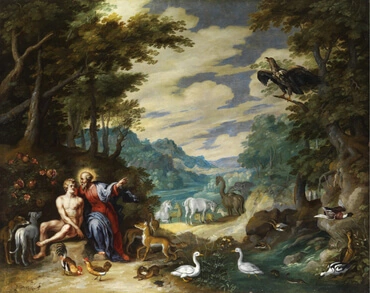505. Then those from the peoples, tribes, tongues, and nations will see their bodies for three and a half days. (11:9) This symbolizes all those who were or who would be caught up in doctrinal falsities and the resulting evil practices at the end of the church still existing, when they have heard and later hear about these two essential elements at the beginning of the New Church, namely, an acknowledgment of the Lord and of works in accordance with the Ten Commandments.
Peoples, tribes, tongues, and nations mean all those of the Protestant Reformed who were or who would be caught up in doctrinal falsities and the resulting evil practices owing to their faith alone. Peoples symbolize people caught up in doctrinal falsities (no. 483), tribes the falsities and evils in the church (no. 349), tongues a confession and acceptance of these (no. 483), and nations people caught up in evil practices (no. 483). Therefore the four together symbolize all those individually and collectively who were or who would be of such a character, thus all those who were in that great city and all those like them who would later come from the world.
The bodies that they would see, those of the two witnesses, symbolize the two essential elements of the New Church, as said in no. 501 above. That they would see them means, symbolically, when they have heard and later hear about them, since it is bodies that are said to be seen, and the two essential elements that are heard.
Three and a half days mean, symbolically, at the end and then the beginning, namely, at the end of the church still existing and the beginning of a new one.
Putting all these things together now into a single meaning, it is apparent that "those from the peoples, tribes, tongues, and nations will see their bodies for three and a half days" has, in the spiritual sense, the symbolic meaning stated above.
Three and a half days mean, symbolically, at the end and then the beginning because a day symbolizes a state, the number three symbolizes something completed to the end, and a half symbolizes a new beginning. For three and half days have the same symbolic meaning as a week, six days of which symbolize something completed to the end, and the seventh day something holy. That is because the number three and a half is one half of seven, and seven days constitute a week; and a number doubled or divided has the same symbolic meaning.
[2] That the number three symbolizes something completed, thus something completed to the end, can be seen from the following accounts in the Word:
That Isaiah was to go naked and barefoot for three years (Isaiah 20:3).
That Jehovah called three times to Samuel, and Samuel ran three times to Eli, and that the third time Eli understood (1 Samuel 3:1-8).
That Elijah stretched himself out three times on the widow's son (1 Kings 17:21).
That Elijah ordered that water be poured on the burnt sacrifice three times (1 Kings 18:34).
That Jesus said that the kingdom of heaven is like leaven, which a woman took and hid in three measures of meal (Matthew 13:33).
That Jesus told Peter he would deny Him three times (Matthew 26:34).
That the Lord asked Peter three times, "Do you love Me?" (John 21:15-17).
That Jonah was in the belly of the whale three days and three nights (Jonah 1:17).
That Jesus said He would destroy the Temple and in three days build it (Matthew 26:61, John 2:19)
That Jesus prayed three times in Gethsemane (Matthew 26:39-44).
That Jesus rose on the third day (Matthew 28:1ff.).
And so on elsewhere, as in Isaiah 16:14; Hosea 6:2; Exodus 3:18; 10:22-23; 19:1, 11, 15-16, 18; Leviticus 19:23-25; Numbers 19:11-22; 31:19-24; Deuteronomy 19:2-4; 26:12; Joshua 1:11; 3:2; 1 Samuel 20:5, 12, 19-20, 35-36, 41; 2 Samuel 24:11-13; Daniel 10:1-3; Mark 12:2, 4-6; Luke 20:12; 13:32-33.
Seven, like three, symbolizes something full and complete, but seven is predicated of holy things, while three is predicated of things not holy.







